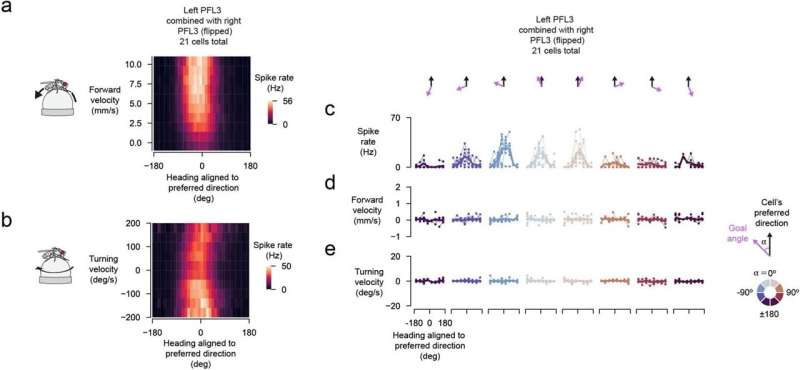This article has been reviewed according to Science X's editorial process and policies. Editors have highlighted the following attributes while ensuring the content's credibility:
fact-checked
peer-reviewed publication
trusted source
proofread
How fruit flies control the brain's 'steering wheel'

When we walk down the street, we have an internal sense of which way we are heading from looking at street signals and physical landmarks and also a sense of where we'd like to go. But how does the brain coordinate between these directions, doing the mental math that tells us which way to turn?
Now, new research describes such a neural process in fruit flies, providing insight into how an animal's brain steers it in the right direction. The study, published in Nature, shows how neurons that signal the direction in which a fly is currently oriented work together with neurons that signal the direction in which way the fly wishes to be oriented––its goal direction—to form a circuit that guides the animal.
"The fundamental question is how brains enable navigation," says Rockefeller's Gaby Maimon. "In this study, we describe neurons that provide goal-direction signals alongside a brain circuit that uses these signals to direct steering."
The cells responsible for signaling which way a fly is oriented in the world (known as "compass" neurons) were first discovered in 2015. A few years later, work from the Maimon lab, and others demonstrated that flies with defective compass neurons are unable to navigate in a straight line along any arbitrary goal direction.
Building on that discovery, Peter Mussells Pires, a student in Maimon's lab and the lead author of this paper, set out to discover the cells responsible for keeping track of a fly's goal angle.
Pires and colleagues used two-photon microscopy to monitor flies' neurons while the insects walked on an air-levitated ball in a virtual environment. Whenever the researchers rotated the virtual environment, the activity of the fly's compass neurons rotated in the brain as well. Interestingly, however, a population of cells identified as FC2 neurons remained unmoved and focused on the original heading.
"Imagine walking uptown in Manhattan, and someone pulls your shoulder and turns you east. Something in your brain continues to track which way is north so that you can return to your original heading," Maimon explains. "In flies, these are FC2 neurons."
To confirm the role of FC2 neurons in tracking a goal, the team used optogenetics—a technique that uses light to control the activity of neurons. By manipulating the activity of FC2 cells, the researchers were able to change the fly's navigation direction in predictable ways. "This was the experiment that really convinced us that these cells can actually determine the fly's goal," Pires says.
Mental math
With heading neurons and goal neurons identified, the team shifted its focus to the brain circuit responsible for combining the two signals. Recent work fleshing out the fly brain connectome—a map detailing the connections between different neurons—helped the researchers zero in on the circuit in question. The connectome made clear that a set of cells, called PFL3 cells, receive inputs from both the compass and goal neurons.
A series of experiments confirmed that PFL3 neurons tell the fly's body which way to turn by influencing the brain's motor system. They do so by comparing internal heading and goal inputs, functioning a bit like the steering wheel of the fly's navigation system. Larry Abbott, a theorist at Columbia University, collaborated with the team to develop a mathematical understanding of the system.
Abbott's model captured how compass and goal signals, which are represented in world or map coordinates (for example, north/east/south/west), are converted into motor-related signals in the body's coordinate system—that is, left and right turns. Complementary results on PFL neurons, closely tied to the present study, are detailed in a parallel Nature paper.
Future work from the Maimon lab will focus on how flies build and store longer-term spatial memories and goals to guide behavior; the goal signal characterized in this study only explains what the flies will do in the next few seconds. Maimon is also curious to learn whether these new findings might catalyze the discovery of similar brain circuits in mammals and, ultimately, humans.
"By studying the fly brain," he says, "we have provided an initial glimpse into how a simple 'thought' is converted into an action. Hopefully, these findings will allow us to understanding more complex forms of this process in mammals down the road."
More information: Gaby Maimon, Converting an allocentric goal into an egocentric steering signal, Nature (2024). DOI: 10.1038/s41586-023-07006-3. www.nature.com/articles/s41586-023-07006-3
Rachel Wilson, Transforming a head direction signal into a goal-oriented steering command, Nature (2024). DOI: 10.1038/s41586-024-07039-2. www.nature.com/articles/s41586-024-07039-2
Journal information: Nature
Provided by Rockefeller University





















